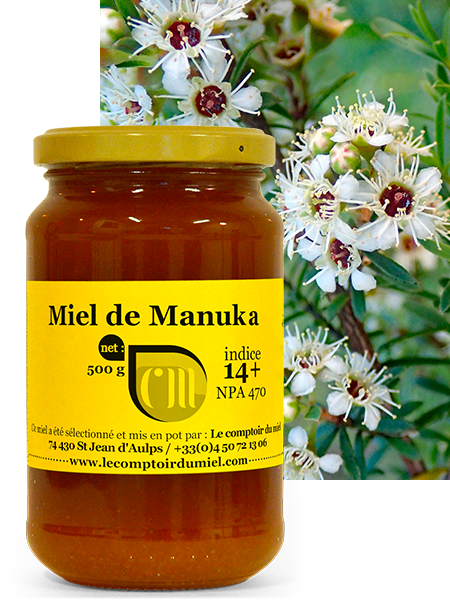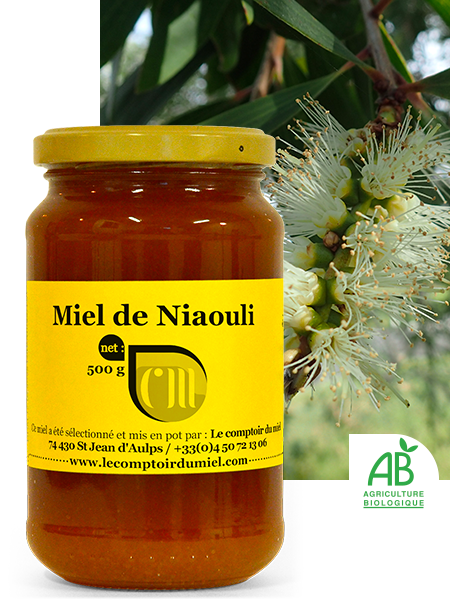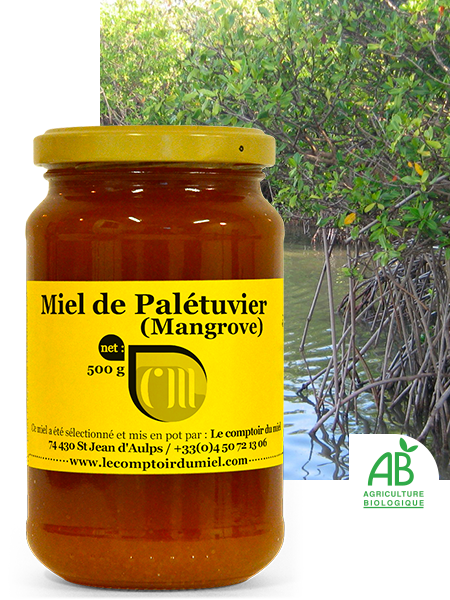Manuka honey comes from the primary forests of New Zealand. It has been used in traditional Maori medicine for centuries.
It is a wild shrub of the myrtaceae family, widespread in New Zealand, Australia and Tasmania. Tasmania. It is highly resistant to harsh conditions. It blooms in early summer (from November to January in this part of the world). Its pretty white flowers are particularly fragrant: bees love them.
Manuka, also known as tea-tree, is traditionally used by the Maoris as a decoction (leaves and flowers) for people suffering from respiratory or urinary problems. urinary problemsbut also for rheumatism. Here we have Manuka Honey index 14 +.
There are 2 varieties of tea-tree in New Zealand:
Manuka leptospermum Scoparium, and Kanuka Kunzéa Ericoïde. It is very difficult, even for laboratory technicians, to differentiate between the two. Indeed, the pollens mix and Kanuka pollen is easily found in Manuka and vice versa.
Our direct sourcing from small beekeepers and cooperatives in the Canterbury area of the South Island gives us a superior guarantee:
Our partner, a French beekeeper, visits his New Zealand beekeeping colleagues twice a year to provide us with this guarantee.
The honey is analyzed before export. It is then tested on arrival in Europe to certify its antibacterial activity to the maximum extent possible.
It is elixir elixir from New Zealandis much more than just an accompaniment to your tea! It’s a truly versatile solution for your health and beauty.
This top-quality honey has unique antibacterial and antioxidant properties, thanks to the high concentration of methylglyoxal (MG) it contains. Its valuable properties make it a natural remedy for soothing sore throats, treating wounds and promoting healing.
Manuka honey’s rich antioxidant content also makes it a valuable ally for your skin. It can help reduce acne, deeply moisturize and reduce the signs of aging.
But not all Manuka honeys are created equal. It’s important to choose a honey that has been tested and certified for its MG content.
What is the MG marker?
Methylglioxal is the active molecule in manuka honey that gives it its many benefits.
MGO or MG (Methylglyoxal) is the component responsible for anti-bacterial activity. This index expresses the quantity of Methylglyoxal per kilogram of honey. For example, a Manuka honey with the characteristics of 200mg/kg would be represented by MGO 200 +. Manuka Health owns the MGO design. MG stands for methylglyoxal and can therefore be used by anyone.
NPA (Non Peroxide Activity): non-peroxide activity. This scale can be compared to a classic phenolic disinfectant. The more powerful the activity, the greater the circle of inhibition around the honey. A 10% phenol solution, for example, is equivalent to a honey labeled NPA +10.
Since April 1, 2020, this is a European trademark registered by Rastenberger GmbH.
UMF (Unique Manuka Factor): this is the most widespread. It is due to a New Zealand association whose aim is to promote Manuka honey locally and on foreign markets.
This premium honey has unique antibacterial and antioxidant properties, thanks to its high concentration of methylglyoxal (MG).
Here are the main characteristic compounds found in Manuka honey index 14 + :
Methylglyoxal ( MG or MGO )is a compound that is primarily responsible for the unique non-peroxide antibacterial activity of Mānuka honey that is not present in other types of honey.
There have been cases of adulteration where synthetically manufactured Methylglyoxal has been added to honey to make fake Manuka honey. Therefore, measuring Methylglyoxal alone is no guarantee of the purity and quality of Manuka honey.
Dihydroxyacetone ( DHA ) is a natural plant compound found in the nectar of Manuka flowers. DHA converts to MGO (or MG) over time in Manuka honey as it matures.
Leptosperine is a unique natural plant compound found only in Manuka honey. It is extremely difficult to make synthetically and is not commercially available. As this compound cannot be added artificially, it is an excellent marker of authenticity.
Discover the many health and beauty benefits of Manuka honey. Let yourself be seduced by this golden elixir that has conquered the world.
How to choose the best Manuka honey :
When choosing Manuka honey, it’s essential to check its methylglyoxal (MG) content. The higher the MG content, the more active and beneficial it is for your health.
Different MG rates for different uses :
100 + : for food use, daily use and preventive use
400 + : used to heal wounds, burns, coughs, bronchitis, tonsillitis, mouth ulcers…
800 +: use in hospitals, helico bacter coli
We have here manuka honey index 14 + which corresponds to an MG content of 470mg/kg.
The science behind Manuka honey’s healing properties:
Professor Peter Molan (researcher at the University of Waikato) has coined the acronym UMF (Unique Manuka Factor or Propriétés uniques à Manuka) to define the unidentified active properties of Manuka honey, not attributable to the hydrogen peroxide properties common to other honeys.
The UMF benchmark is a comparison of honey’s activity level against Phenol, which is a detergent. The UMF and IAA benchmarks indicated the approximate activity level of honey, at a time when its active molecule was not yet known.
Science has validated its therapeutic properties, which help fight the most resistant bacteria (e.g. Staphylococcus aureus – Helicobacter pylori – Streptococcus…). Containing no hydrogen peroxide or glucose oxidase, Manuka honey’s bactericidal power is extremely high.
Discover the many health and beauty benefits of Manuka honey. Let yourself be seduced by this golden elixir that has conquered the world.
The health benefits of Manuka honey :
Manuka honey is produced from the nectar of the flowers of the Manuka tree, a shrub endemic to New Zealand. This honey is famous for its high concentration of methylglyoxal (MG), a compound that gives it its unique properties.
MG is a powerful antibacterial compound, helping to fight infection and promote healing. Manuka honey also contains enzymes, antioxidants and essential nutrients, making it a superfood for your health and well-being.
What’s more, scientific research supports Manuka honey’s many benefits. Indeed, studies have shown that Manuka honey can inhibit the growth of certain antibiotic-resistant bacteria, making it a promising choice for the treatment of infections!
In addition, Manuka honey has been studied for its anti-inflammatory, antioxidant and wound-healing properties. It can help reduce inflammation, protect cells against free radical damage and promote wound healing.
It is also a natural remedy for joint and muscle pain. It can also help regulate blood sugar levels and improve heart health.
Manuka honey offers a multitude of health benefits. Because of its antibacterial properties, it can be used to relieve sore throats, respiratory infections and skin wounds. But it also helps boost the immune system and aid digestion.
Manuka honey index 14 + for skin care:
Our skin reflects our health and well-being. Manuka honey index 14+ is a real treasure for the skin, thanks to its antioxidant and antibacterial properties.
For acne sufferers, Manuka honey can be an effective natural solution. Indeed, its antibacterial properties help fight acne-causing bacteria, while its anti-inflammatory properties help reduce redness and inflammation.
What’s more, Manuka honey is an excellent skin moisturizer. In fact, it helps retain moisture, contributing to softer, more supple skin. It can also help reduce signs of aging, such as fine lines and wrinkles. Not to be underestimated!
Include index 14 + Manuka honey in your diet:
Manuka honey can be used in many different ways in your diet. You can add it to your tea, smoothies or yoghurt for an extra sweet flavor taste that’s good for your health.
It can also be used as a sugar substitute in your recipes, adding a touch of natural sweetness. Try it in your sauces, marinades or even desserts for a healthier, more delicious option.
Manuka honey products for beauty and well-being:
Manuka honey can be used to create natural and effective skin care products. Here are a few simple recipes to try at home:
- Moisturizing facial mask: Mix a tablespoon of Manuka honey with a tablespoon of plain yoghurt and a tablespoon of sweet almond oil. Apply to your face and leave on for 15 minutes before rinsing off with lukewarm water.
- Body scrub: Mix a tablespoon of Manuka honey with a tablespoon of brown sugar and a tablespoon of coconut oil. Gently massage into damp skin, then rinse off with lukewarm water.
- Nourishing lip balm: Mix one tablespoon of Manuka honey with one tablespoon of melted shea butter. Add a tablespoon of sweet almond oil. Then pour the mixture into a small jar and leave to cool until it hardens. Once hardened, you can apply it to your lips to moisturize and protect them.
If you prefer to use ready-to-use products, many brands offer beauty and wellness products based on Manuka honey. You can find moisturizers, face masks, lip balms and much more.
Did you know?
Far more Manuka honey is consumed than harvested!




Reviews
There are no reviews yet.